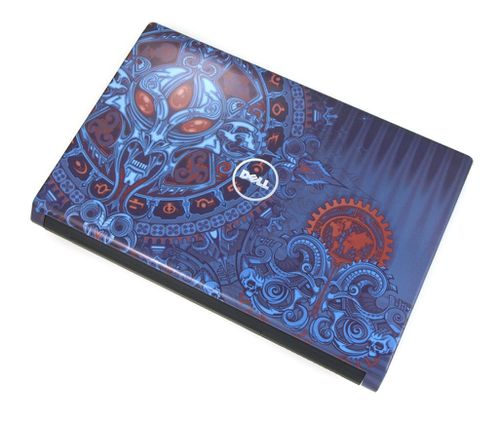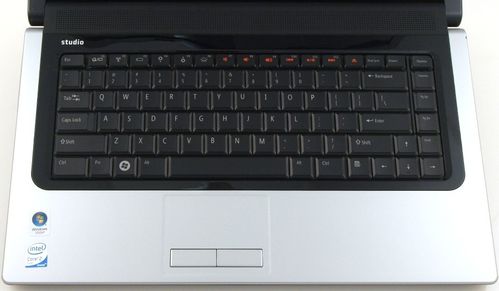Dell Studio 15 (1555) Review
 If you're one of the many consumers around the globe looking for a multimedia family PC with a 15-inch screen, then the updated Dell Studio 15 (1555) probably has all the features you're looking for in a new laptop. Now with more than 200 customizable designs available from the Dell Design Studio, is the Studio 15 the most attractive 15-inch notebook on the market? Let's take a closer look and find out.
If you're one of the many consumers around the globe looking for a multimedia family PC with a 15-inch screen, then the updated Dell Studio 15 (1555) probably has all the features you're looking for in a new laptop. Now with more than 200 customizable designs available from the Dell Design Studio, is the Studio 15 the most attractive 15-inch notebook on the market? Let's take a closer look and find out.
Build and Design
I'm sure some of our readers will be a little confused by this review and wonder, "Didn't NotebookReview.com already review the Studio 15?" The answer is yes and no ... just to confuse you even more. Dell decided that the original Studio 15 (model 1535) needed some improvements, and when LCD manufacturers stopped making 16:10 ratio LCDs and switched to 16:9 ratio screens it gave Dell the perfect opportunity to launch a new Studio 15 (1555).
With that being said, the changes between the original Studio 15 (1535) and the new Studio 15 (1555) are fairly minor. Dell obviously increased the width of the notebook in order to accommodate the wider 15.6" LCD with its 16:9 aspect ratio. The new Studio 15 also features a black screen bezel compared to the silver bezel on the old Studio 15. The only other obvious changes are the removal of dedicated media buttons and changes to the port layout. We'll talk more on those changes later in the review.
Overall, The Studio 15 is still an impressive looking desktop replacement. I use the term "desktop replacement" because most people in the market for a 15-inch notebook aren't planning to haul their notebook everywhere during frequent airline travel.
While the Studio 15 isn't exactly a thin-and-light notebook designed for mobility, it's still a very portable multimedia entertainment notebook. The Studio 1555 takes several design elements from the earlier Studio 1535: the wedge-shaped profile, drop hinge, and slot-loading optical drive.
The Studio 15 is available in your choice of six colors: Plum Purple, Promise Pink, Midnight Blue, Ruby Red, Spring Green or standard Black Chainlink. If those aren't enough options for you, the Dell Design Studio offers the Studio 15 in your choice of more than 200 different designs by various artists. We selected the "XenoMayan" lid design and also went one step further and selected the "Haab3" variation of the design by the Tweeqim artist studio.
When closed the Studio 15 doesn't feel as sturdy as you might expect. The screen lid shows significant flex under very light pressure. Considering the added cost of the fancy lid I don't think it's too much to expect some reinforcement so that the lid feels firm when you hold it. Likewise, the bottom of the chassis shows quite a bit of flex near the center of the notebook. Long story short: The Studio 15 does not feel particularly rugged. I suspect the plastics used will withstand regular day-to-day abuse inside a backpack or on a desk without showing too much wear and tear, but the laptop just doesn't "feel" solid.
The bottom of the notebook features the battery and a single access plate that must be removed in order to upgrade the RAM, hard drive, or replace any additional components. On the bright side, Dell improved the access panel on the Studio 1555 so that you only have to remove three screws to upgrade the RAM or the hard drive. Unfortunately, as previously mentioned, the bottom of the notebook doesn't feel particularly sturdy.
Screen and Speakers
The 15.6-inch high definition (1920x1080) panel on the Studio 15 rates fairly average with vibrant colors and excellent contrast. The display panel in our review unit appears to be an LG model (LGD020B). The LED backlighting in our review unit is nice and bright, but we did notice that the brightness was slightly uneven in the upper right corner of the screen. Yes, it is a 16:9 screen ratio, but this is starting to become standard for all notebooks and isn't really a problem when you've got a higher resolution panel like this one. Horizontal viewing angles are extremely good, so you won't have any trouble sharing a movie with a friend or two. Upper vertical viewing angles are above average since the colors don't wash out too much when viewed from above but colors begin to distort and invert as you move the screen back.
UPDATE: When we originally reviewed the Studio 15 (1555) we certainly weren't impressed. The stereo speakers located beneath the screen produced weak and flat sound and we couldn't detect anything from the built-in subwoofer. We sent our review unit back to Dell for service and upon its return all we can say is, WOW!
The subwoofer adds a surprising impressive level of bass to the speakers in the Studio 15. The bass is actually strong enough to feel with your hand on the keyboard. Overall the sound pretty good with crisp high notes from the main speakers and milder bass from the subwoofer. In short, the fixed subwoofer makes a world of difference and is much better than before. I still think the audio could use some tuning to lower the volume of the main speakers to match the subwoofer, but it's a minor issue.
Overall, the built-in speakers and subwoofer are good and external speakers or headphones are only a must-have accessory with this laptop if you want privacy.
Dell Studio 1555 Keyboard and Touchpad
The backlit keyboard on our review unit of the Studio 15 is very nice and similar to the one on the original Studio 15. The keyboard is quite comfortable to type on with reasonable key size and spacing. There is some obvious flex when typing pressure is applied around the "L" key, but the left side of the keyboard is reasonably firm. If Dell put some additional reinforcement under the right side of the keyboard then this would be a nearly perfect keyboard.
The biggest difference between the keyboard on the Studio 1535 and the new Studio 1555 is that the new keyboard lacks dedicated media buttons. Instead, the new keyboard moves the media controls to the F-keys on the top row of the keyboard. On one hand I really like this change because of gives you physical controls for several different functions. On the other hand, if you frequently use the F-keys for things like refreshing your web browser you now have to press the Fn key as well.
The Synaptics-based touchpad is large and comfortable to use with a nice texture. Sensitivity is good, accurately tracking finger movement with little pressure on the surface. The multi-touch gestures (such as zoom in and zoom out) are easy to use. The only thing I didn't like about the touchpad is that Dell uses their own touchpad drivers rather than the standard Synaptics drivers ... making it more difficult to adjust settings. The touchpad buttons themselves have excellent feedback with a deep throw and well-cushioned press.
Ports and Features
The port selection on the Studio 1555 is nice, but surprisingly not as good as the original Studio 15 (1535). The new Studio 15 has one fewer USB ports and only has an ExpressCard/34 slot rather than an ExpressCard/54 slot. Granted, many 15-inch notebooks only have three USB ports, but now that most 10-inch netbooks have three USB ports it seems odd when a 15-inch notebook doesn't have at least four. Still, the inclusion of eSATA, FireWire and HDMI for connecting your laptop to a larger HDTV or external monitor are welcome features to have on a multimedia notebook.
Performance
The performance of the Studio 15 with an Intel Core 2 Duo P8600 processor and ATI Radeon 4570 discrete graphics is exceptionally good. This is the level of performance we like to see from multimedia oriented notebooks with discrete graphics. Whether you're watching a Blu-ray movie, playing a few levels of Left 4 Dead, or streaming video via YouTube HD this notebook has the power to get the job done.
We would have loved to see even more discrete graphics options available on the Dell website, but the ATI Radeon options should provide more than enough performance for average consumers looking to purchase this laptop for multimedia use around the home.
Battery
With the screen brightness set to 70%, wireless active, and the Vista power profile set to "Balanced" the Studio 15 stayed on for 3 hours and 42 minutes of constant use. To be honest, discrete graphics and 1080p displays usually result in less-than-spectacular battery life, but we were hoping to see more from this notebook with the 9-cell 85Wh extended life battery. Bottom line, this is perfectly fine for a desktop replacement or for average use around the house, but if you need a notebook to be your constant travel companion then the Studio 15 might not be the best choice.
Heat and Noise
The cooling system does an acceptable job keeping temperatures under control. The area around the hard drive, RAM, and wireless cards produced the most obvious heat on the external surfaces of the notebook, but temperatures weren't hot enough to prevent me from using the Studio 15 as a "laptop." The temperature readings below (listed in degrees Fahrenheit) were taken after stressing the system with performance benchmarks for 30 minutes and should reflect typical external temperatures after more than an hour of serious use.
Noise wasn't much of an issue with the Studio 15. The slot-loading optical drive made some noise when inserting or ejecting a disk but it was average for the slot-loading drives we've had in our office. The cooling fan is loud enough to be noticed in a quiet room, but shouldn't be an issue unless you must have absolute silence.
The hard drive was likewise quiet and it seems as if Dell has done a good job finding ways to minimize the noise coming from the hard drive. We did notice some sporadic CPU/southbridge whine coming from our review unit, but it was extremely high-frequency noise and might not be common to all Studio 15 models.
Conclusion
The Dell Studio 15 (1555) offers an impressive balance of customizable features and performance at a fair price. The modern looks, custom lid options, and affordable upgrades are sure to make this a popular notebook for many consumers. Unfortunately, the lackluster build quality, and average port selection will probably leave several owners wanting more.
If you're in the market for a nice family PC that has a fantastic range of multimedia features at a good price then the Dell Studio 15 is worth consideration. If you can't look beyond the flexible plastics then luckily there are many alternatives on the market with 15-inch screens.


